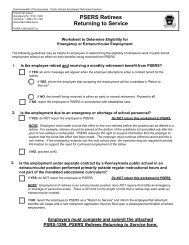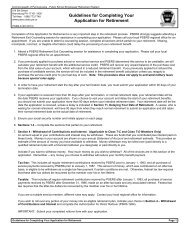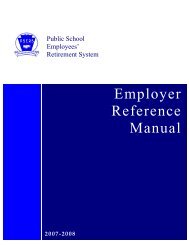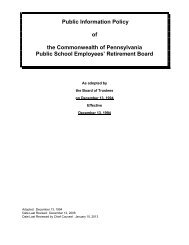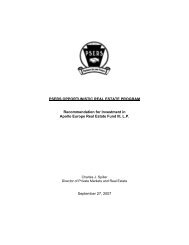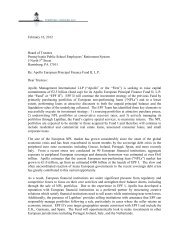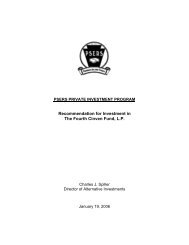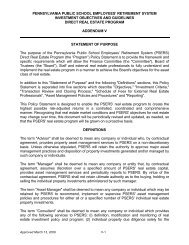a complete copy of the 2012 CAFR Report! - PSERs
a complete copy of the 2012 CAFR Report! - PSERs
a complete copy of the 2012 CAFR Report! - PSERs
You also want an ePaper? Increase the reach of your titles
YUMPU automatically turns print PDFs into web optimized ePapers that Google loves.
INVESTMENT SECTION<br />
System’s ability to achieve its funding and long-term investment goals and objectives; and,<br />
2. The System’s assets shall be invested so that <strong>the</strong> probability <strong>of</strong> investment losses (as measured by <strong>the</strong> Policy<br />
Index) in excess <strong>of</strong> 15% in any one year is no greater than 2.5% (or two standard deviations below <strong>the</strong> expected<br />
return).<br />
To achieve <strong>the</strong>se objectives, <strong>the</strong> Board meets during <strong>the</strong> first quarter <strong>of</strong> <strong>the</strong> calendar year to review <strong>the</strong> overall asset<br />
allocation plan and investment policies for <strong>the</strong> System. Implementation <strong>of</strong> investment policies is accomplished<br />
through <strong>the</strong> use <strong>of</strong> external investment management firms who act as agents for <strong>the</strong> System and through <strong>the</strong> use <strong>of</strong><br />
internal investment managers. The Board also retains various investment consultants to assist with <strong>the</strong> formulation<br />
and implementation <strong>of</strong> investment policies.<br />
Operations<br />
The Board, via <strong>the</strong> Finance Committee, provides oversight <strong>of</strong> investment activities. The Finance Committee generally<br />
conducts seven meetings per year and may meet more frequently as needed. Investment Office staff, as well as<br />
external investment advisors and Investment Accounting staff, assist <strong>the</strong> Board in achieving investment objectives<br />
and monitoring compliance with investment policies. For <strong>the</strong> fiscal year ended June 30, <strong>2012</strong>, Wilshire Associates<br />
Incorporated (Wilshire) served as <strong>the</strong> general investment consultant to assist <strong>the</strong> Board in formalizing investment<br />
objectives, establishing an asset allocation plan, conducting investment advisor searches, reviewing performance, and<br />
commenting on compliance with investment policies. In addition, <strong>the</strong> Board utilized Aksia, LLC as an absolute return<br />
consultant, Courtland Partners, Ltd. as a real estate consultant, and Portfolio Advisors, LLC as an alternative investment<br />
consultant. Alternative investments generally consist <strong>of</strong> investments in private debt, private equity, and venture capital<br />
limited partnerships. Investment Office staff implement <strong>the</strong> investment decisions within <strong>the</strong> guidelines established in<br />
<strong>the</strong> Investment Policy Statement, Objectives and Guidelines regarding asset allocation, manager selection, security<br />
selection, and o<strong>the</strong>r objectives directed by <strong>the</strong> Board.<br />
The Board employs both external investment management firms and internal investment managers to manage <strong>the</strong><br />
investment portfolio <strong>of</strong> <strong>the</strong> System. At fiscal year end, 54 external public market investment management firms<br />
were managing $14.4 billion in assets <strong>of</strong> <strong>the</strong> System, $14.7 billion in assets were managed by <strong>the</strong> System’s internal<br />
investment managers, and <strong>the</strong> remaining $19.4 billion in assets were managed by numerous emerging, alternative<br />
investment, and real estate investment managers. The performance <strong>of</strong> each external investment management firm and<br />
each internal manager is monitored quarterly against a pre-established benchmark as well as <strong>the</strong> performance <strong>of</strong> <strong>the</strong><br />
manager’s peer group.<br />
Asset Allocation<br />
The Board reviews <strong>the</strong> long-term asset allocation targets <strong>of</strong> <strong>the</strong> System during <strong>the</strong> first quarter <strong>of</strong> each calendar<br />
year. The Board will consult with its actuary, consultants, Investment Office staff, and o<strong>the</strong>r sources <strong>of</strong><br />
information it deems appropriate in formulating <strong>the</strong> asset allocation plan. The Board believes that <strong>the</strong> level<br />
<strong>of</strong> risk assumed by <strong>the</strong> System is largely determined by <strong>the</strong> Board’s strategic asset allocation plan. The<br />
Board, in determining its long-term asset allocation, shall take <strong>the</strong> following factors into consideration:<br />
• The System’s investment time horizon;<br />
• The demographics <strong>of</strong> <strong>the</strong> plan participants and beneficiaries;<br />
• The cash flow requirements <strong>of</strong> <strong>the</strong> System;<br />
• The actuarial assumptions approved by <strong>the</strong> Board;<br />
• The funded status <strong>of</strong> <strong>the</strong> System;<br />
• The Board’s willingness and ability to take risk; and,<br />
• The employers’ (Commonwealth and school districts) financial strength.<br />
In establishing <strong>the</strong> asset allocation for <strong>the</strong> System, <strong>the</strong> Board considers capital market expectations for expected return,<br />
volatility, and asset class correlations as prepared by its general investment consultant. The current long-term, topdown<br />
asset allocation targets <strong>of</strong> <strong>the</strong> Board are discussed in <strong>the</strong> following paragraphs.<br />
The long-term target allocation as <strong>of</strong> June 30, <strong>2012</strong> included an equity target allocation <strong>of</strong> 21.5% consisting <strong>of</strong> publicly<br />
traded stocks. Specific targets have been established for U.S. equity exposure (10.3%) and non-U.S. equity exposure<br />
PAGE 67






